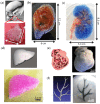3D Printing of Organs-On-Chips
- PMID: 28952489
- PMCID: PMC5590440
- DOI: 10.3390/bioengineering4010010
3D Printing of Organs-On-Chips
Abstract
Organ-on-a-chip engineering aims to create artificial living organs that mimic the complex and physiological responses of real organs, in order to test drugs by precisely manipulating the cells and their microenvironments. To achieve this, the artificial organs should to be microfabricated with an extracellular matrix (ECM) and various types of cells, and should recapitulate morphogenesis, cell differentiation, and functions according to the native organ. A promising strategy is 3D printing, which precisely controls the spatial distribution and layer-by-layer assembly of cells, ECMs, and other biomaterials. Owing to this unique advantage, integration of 3D printing into organ-on-a-chip engineering can facilitate the creation of micro-organs with heterogeneity, a desired 3D cellular arrangement, tissue-specific functions, or even cyclic movement within a microfluidic device. Moreover, fully 3D-printed organs-on-chips more easily incorporate other mechanical and electrical components with the chips, and can be commercialized via automated massive production. Herein, we discuss the recent advances and the potential of 3D cell-printing technology in engineering organs-on-chips, and provides the future perspectives of this technology to establish the highly reliable and useful drug-screening platforms.
Keywords: 3D printing; bioprinting; cell-printing; in vitro disease model; in vitro tissue model; organ-on-a-chip.
Conflict of interest statement
The authors declare no conflict of interest.
Figures






Similar articles
-
Bioprinting of 3D tissues/organs combined with microfluidics.RSC Adv. 2018 Jun 19;8(39):21712-21727. doi: 10.1039/c8ra03022g. eCollection 2018 Jun 13. RSC Adv. 2018. PMID: 35541704 Free PMC article. Review.
-
The crossing and integration between microfluidic technology and 3D printing for organ-on-chips.J Mater Chem B. 2018 Oct 21;6(39):6191-6206. doi: 10.1039/c8tb01661e. Epub 2018 Sep 13. J Mater Chem B. 2018. PMID: 32254609
-
Recent Trends in Decellularized Extracellular Matrix Bioinks for 3D Printing: An Updated Review.Int J Mol Sci. 2019 Sep 18;20(18):4628. doi: 10.3390/ijms20184628. Int J Mol Sci. 2019. PMID: 31540457 Free PMC article. Review.
-
Bioprinting on Organ-on-Chip: Development and Applications.Biosensors (Basel). 2022 Dec 6;12(12):1135. doi: 10.3390/bios12121135. Biosensors (Basel). 2022. PMID: 36551101 Free PMC article. Review.
-
Microfluidic bioprinting for organ-on-a-chip models.Drug Discov Today. 2019 Jun;24(6):1248-1257. doi: 10.1016/j.drudis.2019.03.025. Epub 2019 Mar 30. Drug Discov Today. 2019. PMID: 30940562 Review.
Cited by
-
Microfluidic Organ-on-A-chip: A Guide to Biomaterial Choice and Fabrication.Int J Mol Sci. 2023 Feb 6;24(4):3232. doi: 10.3390/ijms24043232. Int J Mol Sci. 2023. PMID: 36834645 Free PMC article. Review.
-
3D Bioprinting of Vascularized Tissues for in vitro and in vivo Applications.Front Bioeng Biotechnol. 2021 May 13;9:664188. doi: 10.3389/fbioe.2021.664188. eCollection 2021. Front Bioeng Biotechnol. 2021. PMID: 34055761 Free PMC article. Review.
-
Bioprinting of 3D tissues/organs combined with microfluidics.RSC Adv. 2018 Jun 19;8(39):21712-21727. doi: 10.1039/c8ra03022g. eCollection 2018 Jun 13. RSC Adv. 2018. PMID: 35541704 Free PMC article. Review.
-
3D Printing: Advancement in Biogenerative Engineering to Combat Shortage of Organs and Bioapplicable Materials.Regen Eng Transl Med. 2022;8(2):173-199. doi: 10.1007/s40883-021-00219-w. Epub 2021 Jul 2. Regen Eng Transl Med. 2022. PMID: 34230892 Free PMC article. Review.
-
3D Bioprinting of In Vitro Models Using Hydrogel-Based Bioinks.Polymers (Basel). 2021 Jan 24;13(3):366. doi: 10.3390/polym13030366. Polymers (Basel). 2021. PMID: 33498852 Free PMC article. Review.
References
-
- Wang L., Liu W., Wang Y., Wang J.-C., Tu Q., Liu R., Wang J. Construction of oxygen and chemical concentration gradients in a single microfluidic device for studying tumor cell–drug interactions in a dynamic hypoxia microenvironment. Lab Chip. 2013;13:695–705. doi: 10.1039/C2LC40661F. - DOI - PubMed
Publication types
LinkOut - more resources
Full Text Sources
Other Literature Sources

